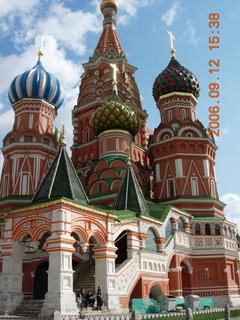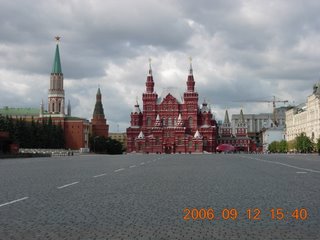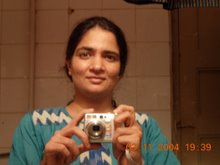| You Are Teal Green |

I am sure that You what to know what kind of green You are! |
Wednesday, April 18, 2007
I came across this question: What kind of green are you? Of course, I wanted to know the answer. This is what I got:
Friday, March 30, 2007
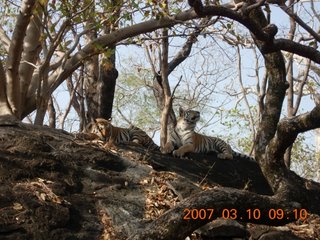
Pench: Where Tigers Still Own the Earth!
I am just back from an amazing 5 day holiday at Pench National Park. I never knew that one could see so many animals in such a short time. Pench is about 90 km away from Nagpur and is one of the lesser known parks- though it is part of the same forest as Kanha. In fact, its right in Seonii district- where Kipling's Jungle book is set. We were in a resort that has 5 star tents - with pukka bathroom, hot and cold water, etc.
We made 8 trips to the Park over the 5 days that we were there- since travel to and fro takes away quite a few hours. We had heard that tiger and leopard sightings at Pench are a common occurrence, and that was definitely our major motivation in choosing it (My mother had done lot of reading and research!) In the first 5 visits to the Park we saw lots and lots of chital, sambar, peacocks (including 2 dancing ones), neelgai, gaur or Indian bison (rather impressive), langoor, jackal, wild dog, jungle cats, and many many birds (including spotted and spectacled owls).
The big cats were very much on our mind and with 3 trips to the forest remaining; we wondered whether we would see them at all.
On Saturday morning (on our 6th visit) we came across an elephant belonging to the forest dept. They had spotted 4 tigers! (This is litter that was born about 18 months ago, so they are full grown, but still stay with their mother). So we hopped on to the elephant and finally saw a tiger in the wild….. (Amma-Baba have been looking for tigers since 1963 when they were in Corbett for 13 months. This was their first!) It was amazing. There were two males lounging on a rock and the two females walking around. They were so close that one could see every whisker clearly....
On Saturday afternoon, we were in high spirits. On the way out of the Park at around 6.20 pm (it closes at 6.30pm) we spotted a leopard on the road way ahead- about half a km ahead. It walked on the road right up to us and then crossed over in front and continued to go along its way. Of course we followed! Unfortunately they take closing time in these places very seriously and so after about a 1 km we said our goodbyes!
On our last trip in the Park,, we told our driver to take us to beautiful parts of the forest which would have relatively less cars, given that it was a Sunday morning. So we drove through gorgeous terrain. And then heard a sambar call. Then we saw a huge tiger- walking alongside in the grass. We watched him for a while and then there was one more. And then one more. We then realised that these were the 4 "cubs" once again!
On Saturday morning (on our 6th visit) we came across an elephant belonging to the forest dept. They had spotted 4 tigers! (This is litter that was born about 18 months ago, so they are full grown, but still stay with their mother). So we hopped on to the elephant and finally saw a tiger in the wild….. (Amma-Baba have been looking for tigers since 1963 when they were in Corbett for 13 months. This was their first!) It was amazing. There were two males lounging on a rock and the two females walking around. They were so close that one could see every whisker clearly....
On Saturday afternoon, we were in high spirits. On the way out of the Park at around 6.20 pm (it closes at 6.30pm) we spotted a leopard on the road way ahead- about half a km ahead. It walked on the road right up to us and then crossed over in front and continued to go along its way. Of course we followed! Unfortunately they take closing time in these places very seriously and so after about a 1 km we said our goodbyes!
On our last trip in the Park,, we told our driver to take us to beautiful parts of the forest which would have relatively less cars, given that it was a Sunday morning. So we drove through gorgeous terrain. And then heard a sambar call. Then we saw a huge tiger- walking alongside in the grass. We watched him for a while and then there was one more. And then one more. We then realised that these were the 4 "cubs" once again!
We went to Pench hoping to see a tiger, but never in our wildest dreams did we think that we would or indeed could, see so many!
The Long Walk Beyond Freedom: South Africa 2007
(by Ilmas Futehally. Published by Strategic Foresight Group)
Johannesburg is a city of contrasts. There are the rich areas and the poor areas. There are the posh suburbs with huge homes, electric fences running around them and the townships made up of thousands of tin huts surrounded by huge mounds of garbage waiting to be cleared. An aerial view of the city shows the hinterland as dry grasslands. This is where the townships are located. But the city itself is the largest artificial forest in the world. Sandton, the part of the city where we were staying compares favourably to any first world city. It has glass-fronted shopping malls with the latest goods from around the globe. It has tall towers reaching for the sky housing hotels, offices, shops and convention centres all interconnected by sky walks to prevent its visitors from having to walk the dangerous streets.
The drive from the airport to the hotel in Sandton was revealing. It was 9 am on a weekday morning. Just outside the Alexandra township, there were a large groups of Black men waiting by the sides of the road- waiting to be offered a job for the day by one of the contactors who are busy rebuilding the affluent parts of the city. This in itself is not unusual. What was different in Johannesburg was the fact that only a fraction of them would end up getting employed on that day - and this showed on their faces, in their postures…. The rate of unemployment in some areas currently stands at 50-60 per cent, and it is the youth that cannot find jobs. And there is a large amount of migration taking place from other African countries, which look upon South Africa as the land of opportunity. The taxi driver spoke about the crime that pervades the city: mainly robberies, armed hold-ups, break-ins and car theft.
Dr Ahmad Motala of the Center for the Study of Violence and Reconciliation (CSVR) described the high rate of crime in Johannesburg as “residual violence”. Before 1994, when South Africa became democratic ending the Apartheid era, there was state violence and severe repression. Despite the introduction of democracy, the socio-economic disparities continued to widen. At the moment, the economy of South Africa is dominated by large conglomerates and it is very difficult for small enterprises to enter the market. As the larger South African companies are going more and more global, there is not much benefit from this trickling down to the poor, enabling them to migrate to the middle class.
Apart from the social and economic deprivation, there is also political deprivation, as there is no credible opposition to the African National Congress (ANC), which is inclusive of all the Black tribes. Thus the high levels of crime and violence in South Africa are a direct result of a deficit of democracy, development and dignity.
The Government of South Africa is very aware of this problem and is doing what it can to change the situation for the people of South Africa, especially the poor living in townships and rural areas. It is planning to introduce low income subsidies and tackling the issue of skill development.
The government of South Africa is also putting emphasis on creating education opportunities for deprived students. Mr Hemant Waghmarae, an educationalist of Indian origin said there are reservations in educational institutions to enable the black youth to participate in the higher levels of the economy, something that they were unable to do during the years of Apartheid. In fact, at that time schooling only until the 8th level was available to Black students. One of the justifications for apartheid was made by White clerics who interpreted certain passages of the Bible to mean that the Black people were only meant for hewing wood and performing manual labour for their White masters. Therefore it was thought unnecessary to educate the Black children beyond purely functional literacy. Now the reservations are creating other kinds of tensions, as students who are doing well in school are loath to give up their seat at an institution of higher education on the justification that it is required to make the playing field level in the future.
Mr Jay Naidoo, former Secretary General of the Congress of South African Trade Unions (COSATU), believes that technology can play a big role in creating inclusion, in bringing in a large number of people into the productive economy, in putting disposable income into the hands of people and in recreating the spirit of entrepreneurship that was destroyed by Apartheid. He was the Minister of Posts, Telecommunications and Broadcasting at the time that mobile phone technology came to South Africa The government’s policy for universal access helped in creating economic activity in the rural areas. For example, prepaid schemes allowed rural farmers to find out about prices and cut out the middle men. New technologies in the future can have a similar positive impact.
Thus, thirteen years into its freedom South Africa is a country that is at a critical junction. Will its long walk beyond freedom lead to greater inclusion for its people and enable all its citizens to get integrated into the mainstream? Will there be social, political and economic empowerment for all its citizens? Will the electric fences that keep people apart come down and give way to a more open society? Will President Mbeki’s vision of creating an African Renaissance, where the African people build the continent without relying on foreign aid, and exploit the natural resources of Africa (of which there are many) for the benefit of Africans at large, rather than a few individuals, succeed? Or will the walls that keep the rich apart from the poor grow higher? Will crime and violence take over and get entrenched in the psyche of the nation? Will parents continue to name their daughters "Yesterday", with a sense of defeat about their future?
(by Ilmas Futehally. Published by Strategic Foresight Group)
Johannesburg is a city of contrasts. There are the rich areas and the poor areas. There are the posh suburbs with huge homes, electric fences running around them and the townships made up of thousands of tin huts surrounded by huge mounds of garbage waiting to be cleared. An aerial view of the city shows the hinterland as dry grasslands. This is where the townships are located. But the city itself is the largest artificial forest in the world. Sandton, the part of the city where we were staying compares favourably to any first world city. It has glass-fronted shopping malls with the latest goods from around the globe. It has tall towers reaching for the sky housing hotels, offices, shops and convention centres all interconnected by sky walks to prevent its visitors from having to walk the dangerous streets.
The drive from the airport to the hotel in Sandton was revealing. It was 9 am on a weekday morning. Just outside the Alexandra township, there were a large groups of Black men waiting by the sides of the road- waiting to be offered a job for the day by one of the contactors who are busy rebuilding the affluent parts of the city. This in itself is not unusual. What was different in Johannesburg was the fact that only a fraction of them would end up getting employed on that day - and this showed on their faces, in their postures…. The rate of unemployment in some areas currently stands at 50-60 per cent, and it is the youth that cannot find jobs. And there is a large amount of migration taking place from other African countries, which look upon South Africa as the land of opportunity. The taxi driver spoke about the crime that pervades the city: mainly robberies, armed hold-ups, break-ins and car theft.
Dr Ahmad Motala of the Center for the Study of Violence and Reconciliation (CSVR) described the high rate of crime in Johannesburg as “residual violence”. Before 1994, when South Africa became democratic ending the Apartheid era, there was state violence and severe repression. Despite the introduction of democracy, the socio-economic disparities continued to widen. At the moment, the economy of South Africa is dominated by large conglomerates and it is very difficult for small enterprises to enter the market. As the larger South African companies are going more and more global, there is not much benefit from this trickling down to the poor, enabling them to migrate to the middle class.
Apart from the social and economic deprivation, there is also political deprivation, as there is no credible opposition to the African National Congress (ANC), which is inclusive of all the Black tribes. Thus the high levels of crime and violence in South Africa are a direct result of a deficit of democracy, development and dignity.
The Government of South Africa is very aware of this problem and is doing what it can to change the situation for the people of South Africa, especially the poor living in townships and rural areas. It is planning to introduce low income subsidies and tackling the issue of skill development.
The government of South Africa is also putting emphasis on creating education opportunities for deprived students. Mr Hemant Waghmarae, an educationalist of Indian origin said there are reservations in educational institutions to enable the black youth to participate in the higher levels of the economy, something that they were unable to do during the years of Apartheid. In fact, at that time schooling only until the 8th level was available to Black students. One of the justifications for apartheid was made by White clerics who interpreted certain passages of the Bible to mean that the Black people were only meant for hewing wood and performing manual labour for their White masters. Therefore it was thought unnecessary to educate the Black children beyond purely functional literacy. Now the reservations are creating other kinds of tensions, as students who are doing well in school are loath to give up their seat at an institution of higher education on the justification that it is required to make the playing field level in the future.
Mr Jay Naidoo, former Secretary General of the Congress of South African Trade Unions (COSATU), believes that technology can play a big role in creating inclusion, in bringing in a large number of people into the productive economy, in putting disposable income into the hands of people and in recreating the spirit of entrepreneurship that was destroyed by Apartheid. He was the Minister of Posts, Telecommunications and Broadcasting at the time that mobile phone technology came to South Africa The government’s policy for universal access helped in creating economic activity in the rural areas. For example, prepaid schemes allowed rural farmers to find out about prices and cut out the middle men. New technologies in the future can have a similar positive impact.
Thus, thirteen years into its freedom South Africa is a country that is at a critical junction. Will its long walk beyond freedom lead to greater inclusion for its people and enable all its citizens to get integrated into the mainstream? Will there be social, political and economic empowerment for all its citizens? Will the electric fences that keep people apart come down and give way to a more open society? Will President Mbeki’s vision of creating an African Renaissance, where the African people build the continent without relying on foreign aid, and exploit the natural resources of Africa (of which there are many) for the benefit of Africans at large, rather than a few individuals, succeed? Or will the walls that keep the rich apart from the poor grow higher? Will crime and violence take over and get entrenched in the psyche of the nation? Will parents continue to name their daughters "Yesterday", with a sense of defeat about their future?
More on Russia
“The US looks at the US-Russia relationship of the 1990s as model to be preserved. For us in Russia, this was our weakest moment, a disaster, never to be repeated”, said Dr Alexei Arbatov, when I met him in Moscow last September. Dr Arbatov is member of the Russian Parliament (State Duma) and the Program Chair for nuclear non-proliferation at the prestigious Carnegie Moscow Center.
Dr Arbatov believes that there are new poles that are emerging and trying to come together to counterbalance US power. These include Germany and Japan, and the power that they wield would be more of an economic nature than of military might.
On Iran and the current crisis, Dr Arbatov has an interesting perspective. He believes that the US nuclear policy towards Iran is heavily tilted because of the US hatred of the current regime in Iran. What is ignored is that the US itself had started the Iranian nuclear programme under the Shah, when some 20 or 30 nuclear reactors were planned. Russia is not so worried. It does not think that a change in Iranian regime is required as long as it adheres to international law. Therefore the Russians look at Iran fundamentally differently than the US. A vast majority of the Russian elite would prefer Iran having a nuclear weapon, rather than have another war. And weaponization is far away as the Iranians at present only have an enrichment policy, not a nuke. To be able to change their nuclear policy, Iranians need to believe that the US is planning to withdraw from Iraq at some stage in the near future. This is unfortunately not a signal that the Republicans can give, as it would be seen as a defeat in Iraq that would strengthen Iran.
Dr Arbatov was a member of the Blix Commission that submitted its report on Weapons of Terror. He believes that the threat of a nuclear weapon falling into the hands of a terrorist organization is very real and large. The AQ Khan network in Pakistan may have started this trend, and the network has not been dismantled or dealt with adequately because of President Musharraf’s support to the US post-9/11. The Americans believe that the Pakistani General can somehow prevent nuclear weapons from falling into the wrong hands and that after him this would no longer be the case.
There are some terrorist groups are actively working on getting nuclear material, and the most probable group that has nuclear weapon grade uranium is the Al Qaeda, given the fact that their goals go well in terms of using a nuclear weapon against a western target. And the Al Qaeda is once again growing in terms of manpower, as well as popularity because of the situation in Afghanistan, Iraq, the success of Iran in using the Hezbollah against Israel……
The most efficient uranium bomb requires about 10 kilograms of uranium, where all the material is used to bring about a critical mass. For a terrorist group the modus operandi would be different. Using 80 kilogram of weapons grade uranium, the crudest of devices could wreak destruction equivalent of that of the Hiroshima bomb.
Dr Arbatov outlined a scary and rather realistic scenario: A terrorist group plants 20 kiloton weapons in Moscow, Washington and London. They go on air and make an announcement that they have the weapons in place- perhaps placed in basements in populated areas of these cities. And of course they can make whatever demands they want and the governments of the world would be forced to take them extremely seriously. The challenge for the terrorist group would be to acquire 20-30 kg of enriched (90%) uranium- not an impossible task given the way in which certain countries have managed to get their nuclear programmes started.
For a terrorist group, a nuclear weapon is ideal. A bio-weapon or chemical weapon could not achieve the same end. The terror group might not be able to prove that they were responsible for the effects of such a weapon, as it may be seen as a natural outbreak. Also, a lot more can be done to protect people against biological or chemical weapons and treat victims of such attacks.
So what can be done to prevent this scary scenario from taking place? There is a need for UN Conventions to entrust the Security Council to investigate leakage of nuclear weapons into the hands of non-state actors. The IAEA could be used to carry out international investigations. There is a need to have information available in time so that the UNSC can carry out the required investigations. If a country refuses to let the investigators carry out their duties, force could be used. However, all this would be possible only if the P5 were seriously interested in non-proliferation and not just in paying lip service to it, believes Dr Arbatov.
“The US looks at the US-Russia relationship of the 1990s as model to be preserved. For us in Russia, this was our weakest moment, a disaster, never to be repeated”, said Dr Alexei Arbatov, when I met him in Moscow last September. Dr Arbatov is member of the Russian Parliament (State Duma) and the Program Chair for nuclear non-proliferation at the prestigious Carnegie Moscow Center.
Dr Arbatov believes that there are new poles that are emerging and trying to come together to counterbalance US power. These include Germany and Japan, and the power that they wield would be more of an economic nature than of military might.
On Iran and the current crisis, Dr Arbatov has an interesting perspective. He believes that the US nuclear policy towards Iran is heavily tilted because of the US hatred of the current regime in Iran. What is ignored is that the US itself had started the Iranian nuclear programme under the Shah, when some 20 or 30 nuclear reactors were planned. Russia is not so worried. It does not think that a change in Iranian regime is required as long as it adheres to international law. Therefore the Russians look at Iran fundamentally differently than the US. A vast majority of the Russian elite would prefer Iran having a nuclear weapon, rather than have another war. And weaponization is far away as the Iranians at present only have an enrichment policy, not a nuke. To be able to change their nuclear policy, Iranians need to believe that the US is planning to withdraw from Iraq at some stage in the near future. This is unfortunately not a signal that the Republicans can give, as it would be seen as a defeat in Iraq that would strengthen Iran.
Dr Arbatov was a member of the Blix Commission that submitted its report on Weapons of Terror. He believes that the threat of a nuclear weapon falling into the hands of a terrorist organization is very real and large. The AQ Khan network in Pakistan may have started this trend, and the network has not been dismantled or dealt with adequately because of President Musharraf’s support to the US post-9/11. The Americans believe that the Pakistani General can somehow prevent nuclear weapons from falling into the wrong hands and that after him this would no longer be the case.
There are some terrorist groups are actively working on getting nuclear material, and the most probable group that has nuclear weapon grade uranium is the Al Qaeda, given the fact that their goals go well in terms of using a nuclear weapon against a western target. And the Al Qaeda is once again growing in terms of manpower, as well as popularity because of the situation in Afghanistan, Iraq, the success of Iran in using the Hezbollah against Israel……
The most efficient uranium bomb requires about 10 kilograms of uranium, where all the material is used to bring about a critical mass. For a terrorist group the modus operandi would be different. Using 80 kilogram of weapons grade uranium, the crudest of devices could wreak destruction equivalent of that of the Hiroshima bomb.
Dr Arbatov outlined a scary and rather realistic scenario: A terrorist group plants 20 kiloton weapons in Moscow, Washington and London. They go on air and make an announcement that they have the weapons in place- perhaps placed in basements in populated areas of these cities. And of course they can make whatever demands they want and the governments of the world would be forced to take them extremely seriously. The challenge for the terrorist group would be to acquire 20-30 kg of enriched (90%) uranium- not an impossible task given the way in which certain countries have managed to get their nuclear programmes started.
For a terrorist group, a nuclear weapon is ideal. A bio-weapon or chemical weapon could not achieve the same end. The terror group might not be able to prove that they were responsible for the effects of such a weapon, as it may be seen as a natural outbreak. Also, a lot more can be done to protect people against biological or chemical weapons and treat victims of such attacks.
So what can be done to prevent this scary scenario from taking place? There is a need for UN Conventions to entrust the Security Council to investigate leakage of nuclear weapons into the hands of non-state actors. The IAEA could be used to carry out international investigations. There is a need to have information available in time so that the UNSC can carry out the required investigations. If a country refuses to let the investigators carry out their duties, force could be used. However, all this would be possible only if the P5 were seriously interested in non-proliferation and not just in paying lip service to it, believes Dr Arbatov.
Friday, October 27, 2006
The Holiday: This year was Cyprus. Went to watch the WRC in September and stayed on to see the beaches. The whole island is so small that we were able to cover it all, forwards as well as backwards! And we had some amazing food and wine. The traditional dish (or rather dishes) there is the mezze. Its like a set meal- one has no choice but eat what they serve. It starts rather innocuously with a couple of salads and dips, then goes on to more substantial vegetarian things, then fish, then chicken, then pork, then lamb. When when thinks that its truly over now, they take away the plates and bring in new ones for the main course! Its really hard work to go through a meal like that. One has to start preparing and planning from breakfast onwards!
We also had some very nice Cypriot wine. I have become quite a convert! The Cypriots are rather large, specially around the middle, and truly friendly, warm and welcoming.
We also had some very nice Cypriot wine. I have become quite a convert! The Cypriots are rather large, specially around the middle, and truly friendly, warm and welcoming.
Wednesday, October 25, 2006
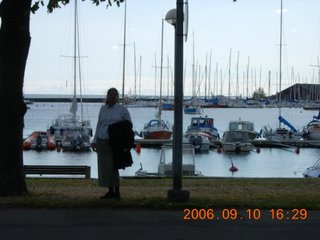
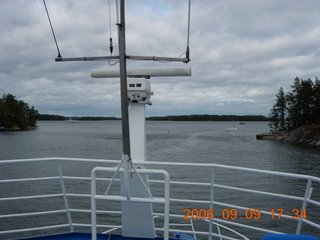
On my birthday, I was in Helsinki. Walked around the city and the harbour area. Went for a ride in the ferry and saw some Finnish islands- many covered with Sauna's. Apparently there are more Saunas in Finland than the Finnish population, so all Finns can sauna at the same time!
I do like the Finns. Without Kimi Raikkonen in F1 and Marcus Grönholm in the WRC, it wouldn't be the same!
Monday, October 23, 2006
Friday, October 06, 2006
I travel a lot on work and I enjoy meeting people, discussing issues and writing about them on www.strategicforesight.com That's where you will find the "official"- photos, articles, interviews with people. This blog is for the non-official part- impressions of cities, people and of course, the birds, animals and trees.
Subscribe to:
Posts (Atom)
